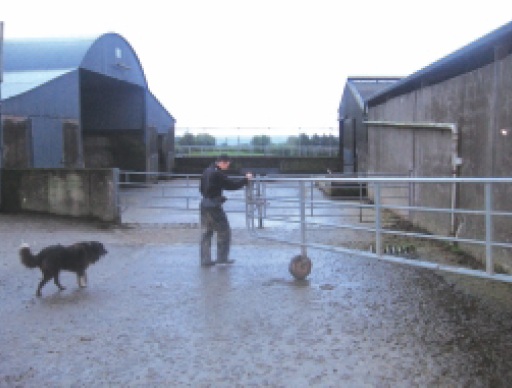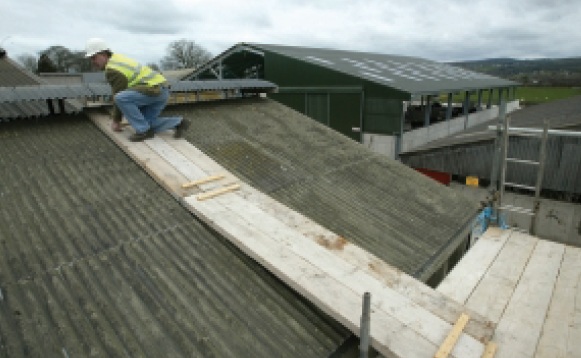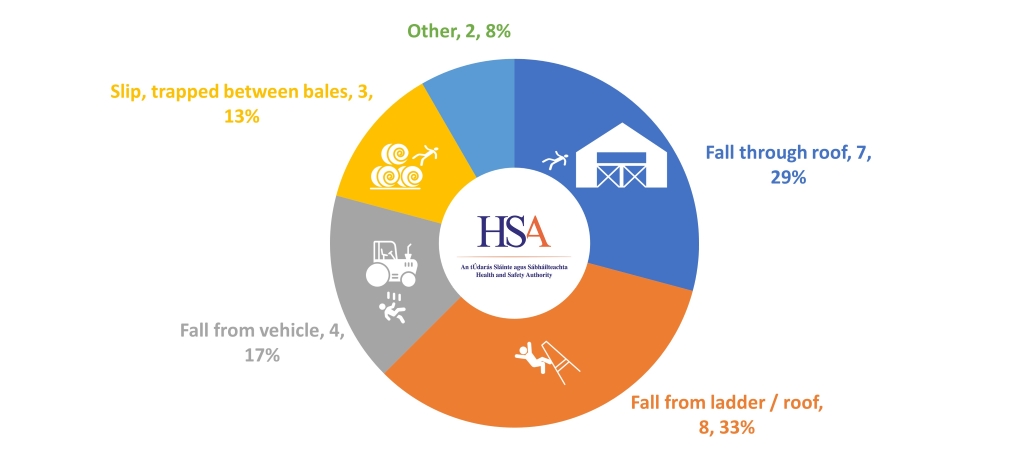Falls & Collapses
Farmyards and buildings
- Pay particular attention to farmyards and buildings because of the level of farm work in these areas and the high level of risk
- Assess the farmyard and buildings for hazards
- Make sure that the farmyard allows orderly movement of people, livestock and machinery
- Leave adequate space between buildings to allow easy turning and movement of machinery
- Identify blind spots or corners where an accident could occur, and put control measures in place
- Make sure that areas used for parking vehicles and mobile equipment are level, as rolling vehicles are a major cause of farmyard accidents
- Ensure a high level of tidiness and provide non-slip surfaces
- Cover manholes and eliminate unnecessary ledges and uneven surfaces
- Provide properly hung gates throughout the farm to ensure easy access
- Avoid sheeted gates where possible as they can be blown by wind
- Secure all swinging doors
- Fit handrails where there is a risk of falling
- Fit safety barriers at unprotected openings in the farmyard
- Open slurry tanks and water tanks should be securely fenced to a height of at least 1.8 metres
- Cattle grids should have an adjacent gate or alternative safe means of access
|  |
Back to top
Building design
- When planning the layout and fixtures of any new building, or modifying existing buildings, check the requirements related to safety and health
- The Farm Building Specifications (AES - Agriculture, Environment and Structures), issued by the Department of Agriculture and Food, give authoritative guidance on safety and health features of buildings and facilities. These specifications are mandatory for obtaining grant aid
- Ensure that livestock have adequate floor space
- Make sure that ventilation is adequate. Use sliding or roller doors where doors need to be more than 1.2 metres wide
- Build in Safety - Advice for Farmers
|  |
Back to top
Bale-stacking at heights
- Falling from stacks or loads of bales is the biggest cause of bale-handling injuries. This can be prevented by building secure stacks and binding stacks and loads
- Particular care is needed when removing bales from stacks, as many people, when trying to free jammed bales, fall from stacks or edges
- Remove big bales from the top first. Never remove bales from the bottom of the stack, as this may leave overhanging bales unsupported
In this video, Sean talks about the suffering and injuries he received when a bale of hay fell on him (4 minutes, 50 seconds).
Back to top
Roof work
- Use safe systems of work when working at heights. Proper roofing ladder / crawling boards should always be used
- Ladders if used should be in good condition, placed at the right angle and securely tied
- Be aware of fragile roof lights/panels
- On a fragile roof, use proper roofing ladders or crawling boards.
- Erect a suitable barrier to prevent falls while carrying out extensive work on roofs
- Consider using competent construction contractors for all work at height
|  |
In this video, agricultural contractor Stanley Scanlan remembers how he was seriously injured when he fell just 9 feet through a skylight.
Back to top
Accessing heights
- Stairs should not have an excessive pitch or angle
- Each step should have an equal rise in height and width
- The sides of stairs should be protected by a wall or railing of sufficient strength
- Where a railing is used, there should be at least two rails, with the lower rail positioned mid-way between the top rail and pitch line
- To prevent falls, lofts, work platforms and walkways should have a protective barrier at the edge
- Over ground slurry tanks and grain or meal bins should have a secure working platform with protective rails and a safe means of access, such as a caged ladder
- Surfaces of stairs and walkways should be firmly fixed and should not become slippery while in use
- Sighting rails should be installed on silage-pit walls. The purpose of these is to indicate the location of the walls to the machine operator loading the silage when the silage is above the walls. They are not intended to prevent a machine overturning. In addition, sighting rails provide protection against a person falling
Ladders
- Much small-scale and short-duration maintenance work involves the use of ladders. Always secure a ladder, even for work that will last only a few minutes
- The base of the ladder must always be placed on firm, level and secure ground. Ideally, the top of the ladder should be tied to a secure part of the building to stop it from slipping
- The ladder needs to be 'footed' or tied off while it is being used
- Ladders must be in good condition. Makeshift, home-made or damaged ladders are dangerous and should never be used
- A ladder must be placed against the side of a building at a safe angle - about 75 degrees to the horizontal (one metre out for every four metres in height).
- Never reach out sideways from a ladder as this will destabilise the ladder and possibly turn it over
- Never carry heavy objects while climbing a ladder
|  |
Scaffolds and platforms
- Extensive work at heights may require the use of scaffolds or properly designed work platforms
- Scaffolds should only be erected by people with appropriate training and experience
- Tower scaffolds can be useful but, because they are light and potentially unstable, need to be used with care. A free-standing tower used out of doors should not be higher than three times its base
Back to top
Fall Fatalities
Falls from a height are the major cause of accidents involving farm buildings. Of particular concern is falling through fragile roofs and from ladders. Collapsing walls or earthen drains also cause deaths.
Fatal and serious accidents often happen when roofs are being quickly repaired. A total of 18% of all deaths in the agricultural sector are associated with falls or collapses. These deaths are particularly linked to fragile roof sheeting and skylights. Weathered skylights become indistinguishable from other roofing material. Both skylights and glass, when painted over, are not recognisable as such and are highly dangerous.
Deaths due to Falls 2014-2023 (13% of all fatalities)

Back to top